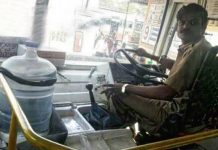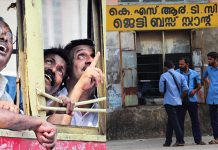Retracing Kerala’s first bus trip, made 77 years ago by the Maharaja of Travancore.
The scorching sun smothers us with an embracing heat that doesn’t let go. It is the vilest day to stand in the queue for a bus but here I am, on an overcrowded footpath in East Fort, the nerve centre of Thiruvananthapuram in Kerala. Behind me, the white of the fort safeguarding the Sree Padmanabhaswamy Temple – the richest temple in the world – and beside me, men in stiff, white shirts pinning up red event badges that read “Bus Day”. People on their way to work pause, inspect the balloon-clad bus, take photos and move on.

The air is dense with chaos until our host jumpstarts towing us back in time. Exactly 77 years into the past when the last ruling Maharaja of Travancore, His Highness Sree Chithira Thirunal Balarama Varma, was expanding the magnitude of the public sector in his state. Known for his farsightedness, his smartest move was to bring down E.G. Salter, the assistant superintendent of the London Passenger Transport Board, under whose supervision 60 Comet chassis with Perkins diesel engines were imported from England. The sudden spurt of freedom made Salter experiment on new designs – these continue to be the standard prototype for most of the state-run buses. On February 20, 1938, the Maharaja and the royal family were the first passengers of the state transport bus that Salter himself drove from East Fort to the Kowdiar Palace.

A couple of spanners, a fresh coat of paint and a string of balloons later, one of the original buses is ready to retrace the same route today in the heart of the city. It’s an ancient double-decker bus, and they’re already unsure about it working today, but there’s a brawl to get to the top floor. I wedge myself in. Two rows ahead of me is Aswathi Thirunal Gowri Laxmi Bai Thampuratti, the niece of the Maharaja. In the 70 years of her life, this is her first bus ride. It is difficult to catch her excitement through the flash of cameras clicking.
The conductor meanders through the crowd, glad to not hand out tickets – it’s a once-in-a-lifetime, free ride of course! He’s a cheeky fellow who wants his passengers to guess the first bus fare. “Four annas,” someone says, and he laughs like a hyena before replying, “Half a chakram.” To put this in perspective, four chakrams add up to one anna or 25 paise.

The first bus route may have been between Afghan Church and Crawford Market in Bombay on July 15, 1926, but our conductor points out with pride that Kerala was the first state to have a double-decker bus. The history lesson is lost on most of the passengers who begin to get drowsy, but the ride succeeds in reiterating our attachment with the Kerala State Road Transport Corporation, which quavered a few months ago when the Kerala High Court revealed the shocking figures of the loss KSRTC suffered – a staggering Rs 60 crores per month.
The bus is a sluggish spectacle on wheels, and moves slowly into its second life, almost fearing the finish line at the end of the 45-minute journey. The gates of the palace are opened and the bus climbs its way into the Kowdiar Palace. The streets are strewn with red seeds from the manjadi trees (Adenanthara pavonina). While I am waiting to get down, I catch a glimpse past the doorway of the palace. A statue of a galloping white horse, a couple of brass lamps and above, a painting of the Maharaja himself, his chest held high, face calm, with a look of glistening pride.
Story by: Akshaya Pillai @ http://www.natgeotraveller.in/



















